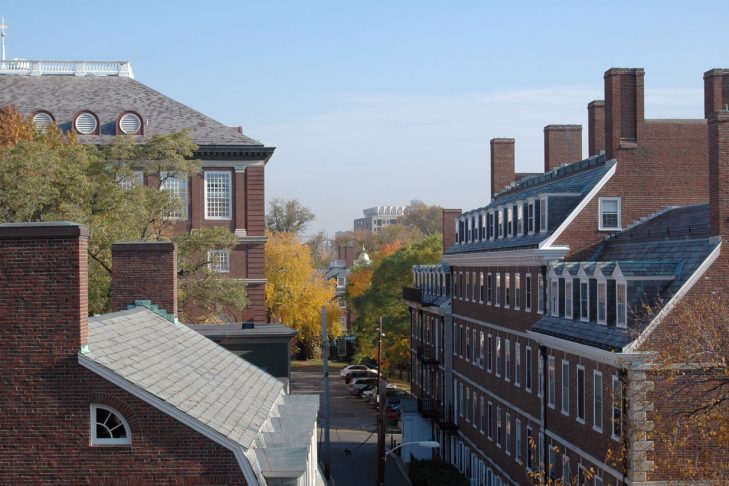As a project manager in CJP’s planning department, I worked closely on the 2015 Greater Boston Jewish Community Study. I thought some of the findings related to Jewish young adults were particularly interesting, and was curious to hear the new trends spoken about as they are lived, rather than simply through the numbers. So I sat down with 25-year-old Basha Goldstein-Weiss, a Jewishly active young adult living in the Cambridge/Somerville area, to get her perspective.
Basha, who was raised and lives in Somerville, is an art teacher in Brookline public schools. She sits on the board of Temple B’nai Brith, an independent egalitarian synagogue in Somerville, and attends other minyanim in Somerville and Cambridge, including the Partnership Minyan at the Tremont Street Shul, the Cambridge Minyan and the Wandering Minyan. She’s also involved in the Camberville Open Beit Midrash, volunteers at Jewish Family & Children’s Service Family Table and worked for URJ Mitzvah Corps.
The study identified a trend of decreased denominational affiliation. Is this true of your particular peer group?
People identify more as “egalitarian” or “partnership”—where a mechitzah divides men and women but a minyan is 10 men and 10 women—much more than in denominational terms. This new way of identifying applies mainly to people who in the past would have called themselves Conservative or Orthodox; a lot of people self-identify as they were raised or not at all.
This change in identifying with a specific synagogue or denomination is in part due to life stage and peer networks. I choose where to celebrate Shabbat each week according to what my friends are doing. This flexibility may change once I have a family, limiting my options to places nearby.
We now know that an increasingly large portion of young adults live in the Cambridge/Somerville areas. What are some of the Jewish happenings there?
There is Moishe House in Cambridge, Temple B’nai Brith in Somerville and a bunch of minyanim. There are learning opportunities through Open Beit Midrash, Temple Israel of Boston’s Riverway Project, Hebrew College’s Eser, CJP’s LEADS and more.
Do you notice a lack of traditional institutions in Cambridge and Somerville, and if so, do you think it affects Jewish life?
People I know who have moved to Boston research the Jewish community and visit both sides of the river, including Jamaica Plain, before deciding where they want to live. They base where they live on what they’re looking for in a Jewish community and how willing they are to travel for it.
There seem to be more social and cultural events on the other side of the river. Jewish young adults in this area participate in religious or learning activities, rather than purely social activities, perhaps because these are the main programs on this side of the river. For instance, Eser and Riverway Project offer programs here, but purely social activities, like Gin & Jews, are not as common.
There’s a Moishe House in Cambridge, which draws a different crowd from other events, attracting people who are looking for something that hadn’t existed nearby. Diversifying the types of Jewish options has the potential to attract a yet unengaged group of Jewish young adults in the area.
As a young board member at Temple B’nai Brith (TBB)—the only traditional-model synagogue in Somerville—what inspires you to be a part of it? What do you see as its strengths? What, if any, are some concerns?
There’s a real sense of community at TBB; it is very much a come-as-you-are environment with people from diverse backgrounds both generally speaking and Jewish. TBB is welcoming and inclusive, with activities such as a Transgender Day of Remembrance potluck each November.
TBB has great programming for adults and families, but as the membership ages, it can be challenging to attract the next generation. Together with Matt Brookner, another young TBB board member, we have created more programming geared toward young adults, successfully attracting local young adults looking for a nearby synagogue.
Maintaining membership numbers is a struggle for alternative communities and traditional-model synagogues. While synagogues may have more consistent communities, minyan membership seems more transient. While some people in my peer group identify as members of different worship communities, they may not be dues-paying members. Families with kids travel less and are more strongly tied to one community. The large student population of this area in particular contributes to greater turnover in membership.
From an institutional perspective, it’s more comforting if there’s consistency in the community and attendance isn’t solely dependent on special events. As a participant in multiple communities, I like the diversity of options and offerings in my area and hope to see them continue to grow.
Read the 2015 Greater Boston Jewish Community Study here.
This post has been contributed by a third party. The opinions, facts and any media content are presented solely by the author, and JewishBoston assumes no responsibility for them. Want to add your voice to the conversation? Publish your own post here. MORE



